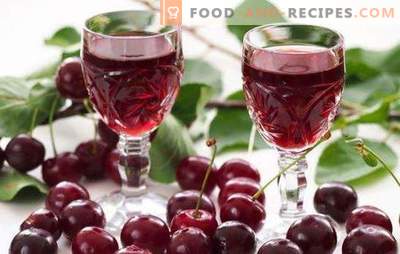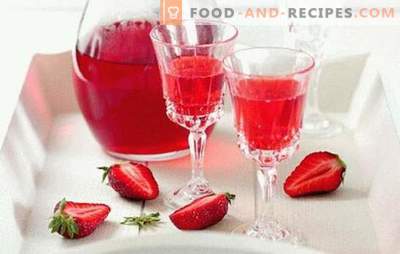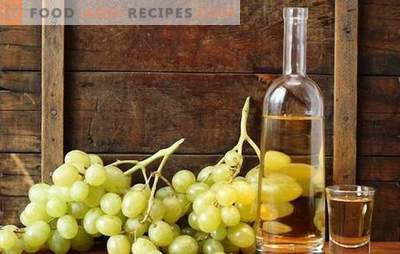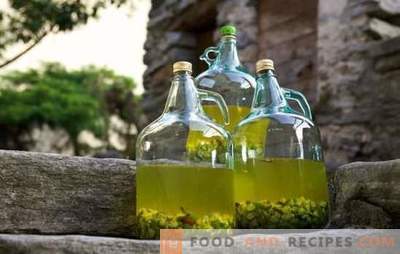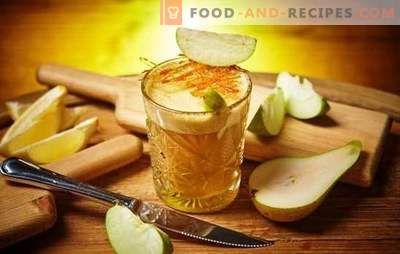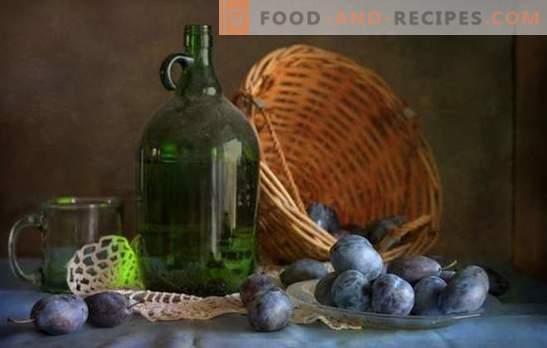
It so happened that not a single holiday feast is complete without alcoholic beverages. Of course, resorting to the services of manufacturers and sellers, offering the most sophisticated and diverse range of liqueurs, would be much easier. But if you serve the guests along with their own hand-cooked dishes, the decanter with crystal clear and friable-sweet cream, there is a chance to leave in their memory an unforgettable and pleasant impression of a holiday spent visiting creative and welcoming hosts.
Pouring plums at home - general cooking principles
First, find out what constitutes a liqueur and how it differs from liqueur or bitter.
Liqueurs are an invention of French monks who skillfully used their knowledge of the beneficial properties of herbs and various fruits infused with alcohol or other strong drinks. To smooth the taste of bitter herbs and roots, infused with alcohols, the monks began to use honey for their preparation.
The basis of liqueur is the same principle of preparation, with the only difference that the basis of traditional Russian drinks is the juice of fruits infused with alcohol, with the addition of sugars, molasses, honey. Thus, the brandy is a subspecies of liqueurs, which has a local name.
It is believed that the liqueur or liqueur should have a sweet taste. Traditional German bitters refute this view, as they are made using a similar technology, but they are distinguished by their bitterness, which is purposefully imparted with the help of wormwood, quinine, ginger and other components for the manufacture of liquor in the German version.
In the presence of a variety of raw materials, it is possible to create a huge variety of recipes of plum liqueurs at home, using the technology of blending (mixing).
Manufacturing technology of plum brandy
The process of making liqueur is quite simple, so it is available for everyone. Moreover, the manufacture of plum liqueurs at home can be done even in the winter, using berry preparations: frozen plums, plums in their own juice or plum jam. First method:
The basis of the liqueur is fruit or berry juice of the first or second plum. Now more about the term “discharge” in this context and detailed instructions for this action. Berries are tightly placed in a glass bottle or enameled container of the required size and covered with vodka, alcohol (drinking) or brandy. You can use special tinctures (extracts) to impart a special flavor to the brandy. The container is covered with gauze or linen and insisted in a warm place inaccessible to sunlight. Temperature 22 ° - 25 ° C. The exposure time is from 6 to 8 weeks. In some sources, you can find recommendations that insisting should be carried out in sunlight. If there is a desire to change the color of the future liqueur, then the sun's rays are necessary. To obtain the natural color of the raw material, it is still worth using dark glassware or opaque containers. Moreover, when stored indoors, it is much easier to create the desired temperature.
After infusion (pouring) the berries are filtered without pressing. This is the first drain. Then the resulting infusion sealed in bottles and temporarily set aside for storage in a dark place. Strained berries fall asleep with sugar and insist for another two weeks, also tightly covering the container. The second time, drain the resulting juice.
The alcoholic infusion obtained during the first drain is mixed with the juice of the second drain.
The finished liqueur is passed through absorbent cotton. With insufficient transparency casting defend to sediment fell to the bottom of the bottle, and filter again. Such liqueur is aged from six months to one year.
Second Method:
Pouring plums can be prepared by fermenting the juice. This method is more like the technology of cooking wine. If, in the manufacture of liqueur in the first way, cutting plums is possible, then for fermentation it is necessary to prepare pulp from the berries. Then the pulp is filled with sugar. The tank is first placed in a warm place to start the fermentation process, and then water is poured into the bottle and closed with a water seal. At a constant temperature of at least 18 ° -20 ° C, the process of fermentation of plum wine is completed in about four to five weeks. After the wine is filtered to obtain the desired transparency. To completely remove the sediment you need to use absorbent cotton. It is better not to squeeze the pulp in order to obtain a sufficiently transparent drink. Ready wine from plums must first be sealed with alcohol. Fortress after adding alcohol should be above 16%. With such an alcohol content in wine, the vital activity of the yeast is suppressed. And only after making sure that the fermentation process is completely stopped, you can put sugar syrup or honey in the liqueur. This cooking method has both advantages and disadvantages. Its complexity lies in the filtering: the drain is very difficult to “give” the juice. During sifting, the berry cannot be squeezed, as it is possible to get a cloudy drink again. But this method allows to reduce the cooking time of plum liqueur at home, because the extraction is accelerated due to the fermentation process.
Third way:
Berries are poured with vodka, brandy or drinking alcohol and kept at a temperature of 60 ° C for 6-7 hours. The raw material acquires a brown color. After evaporation, the plums are filtered through a sieve and sugar syrup based on water or juice is added to the alcoholic infusion.
Fourth method:
The berries are laid out in banks on 3/4 of the volume, sprinkling them with sugar, and pasteurized banks to separate the juice. The cooled juice is drained and vodka is added. To the berries quickly separated the juice, they are cut.
The third and fourth methods allow you to prepare a liqueur for a day.
Allowed, as already mentioned, blending, as well as the use of spicy additives to create a variety of flavors. Pouring create using alcohol tinctures of almonds, roses, cinnamon, vanilla, as well as brandy and fruit essences.
About the quality of raw materials.
Quality product can be obtained from the relevant material.
Plum
First of all, you need to pay attention to the preparation of berries for processing. If for the preparation of the brandy, fresh berries are used from their own garden or bought from the market, they must be sorted. Accidentally getting rotten berries spoil the work.
If it is intended to prepare the liqueur by fermentation, then you do not need to wash the plums. On the skin there are wild yeast, necessary for the “start” of fermentation. Collecting a crop on the site, it is necessary to use only the berries picked in a tree.
For the preparation of liqueurs suitable ripe fruit, with sufficient sugar content. Immature plums can give a grassy and sour taste in the liqueur. The most preferred varieties of plums:
“Ugorka” or “Hungarian”,
"Greengage",
"Mirabel",
“Golden ball”.
It is allowed to use frozen berries for making liqueur - they even “give away” juice better. Here it is worth only paying attention to the degree of ripeness of plums, which they reached before freezing. The use of frozen raw materials allows you to make the pouring, even in winter.
To prepare the liqueur, the stones from the plum can not be removed. But the use of raw materials together with the stone gives a tartness to the finished product, which, of course, must be considered when laying the fruit.
Alcohol, Vodka, Cognac
Alcohol-based ingredients also have high demands. In addition to safety, these components should not contain unpleasant odors that will spoil the taste of the brandy. Allowed to use drinking (wine) alcohol, diluted with water, vodka or cognac products that meet the requirements of GOST. In the case of homemade brandy or moonshine, it is desirable to pay special attention to methods of cleaning them.
Ratio of the main components of the brandy
Of course, these indicators are largely dependent on personal preferences. But, despite the fact that the pouring is mainly a home-made product, it still has some classification according to the content of the main raw material (in this case, the plum variety), sugar and alcohol.
According to the raw material composition, the brandy can be made of plum “Renklod”, “Golden ball” and so on. As a kind of plums, the use of prunes and cherry plums is allowed as the main fruit raw material for the preparation of the brandy. The title of the brandy may reflect the content of the additional component:
Almond
Cinnamon,
Vanilla.
The range of alcohol content in liqueurs can also be different. According to recognized industrial standards, the strength of the brandy can be 18-20%. But for the preparation of this alcoholic drink in a home distillery, the requirements for the fortress can be neglected. Moreover, the liqueur is a subtype of liqueur, whose fortress is significantly higher. Therefore, the brandy can be dessert (up to 16%), low-degree (up to 25-28%), strong (up to 45%). The strength of the brandy is regulated by the amount of added water (juice). The content of sugar or honey also varies, depending on the wishes. Here it is only necessary to take into account that the softness of the taste of strong liqueur is achieved by increasing the amount of sugar.
In most common recipes, the amount of sugar is 200-300 grams of granulated sugar per kilogram of plums. Perhaps, if the raw material has sufficient maturity, this amount of sugar will be quite enough. It is appropriate to change the weight of sugar separately in each case. And, of course, it is also necessary to remember that good liqueur in ready-made form should have a thick, stretching consistency, which, of course, is achieved due to the sugar content in it. In some recipes, the amount of sugar per kilogram of raw material can reach 400 grams (40%) and higher. Before adding sugar is better to dissolve in a small amount of water or juice, in order to achieve rapid mixing and a uniform consistency.
Storage
Slightly grape liqueur is best kept in the refrigerator. Strong plum liqueurs are stored at room temperature. Be sure to with long-term storage should pay attention to the quality of the closure. The taste of the liqueur improves accordingly with the duration of storage, as with vintage wines.
Recipe 1. Pouring from plums at home “Honey”
Raw materials:
• Plum “Golden ball” (yellow) 3 kg
• Linden honey 700 g
• Linden color 200 g
• Vodka 1.5 liters
• Purified water)
Cooking:
Preparation of this liqueur will have to start in the collection season of lime blossom. You can use a lime color, bought in a pharmacy. In this case, the flowers will need half the specified amount. But from fresh linden flowers the tincture is much more fragrant. Pour the flowers with vodka, and tightly closing the jar, leave in a dark place for three weeks. After squeezing squeeze and strain. Again pass through a layer of gauze to get a clean infusion. If there is no lime honey, then you can use any floral honey with a neutral taste. Further, for the preparation of the liqueur - according to the first method described above.
Recipe 2. Pouring from the plum at home “Almond”
Raw materials:
• Almond nut 300 g
• Almond essence 5 mg
• Cognac (any) 1,4 l
• Plum “Hungarian” 3 kg
• Sugar 1.2 kg
Cooking:
Dry the almond nut, crush it in a mortar and put it in a linen bag. Put a bag of nuts in a tightly closed, light-transmitting glass or ceramic dish, pour out the essence and cognac. You can choose any cognac or brandy, at your discretion. After 2 weeks cognac drain. Into the prepared dishes lay the washed and chopped plums, pouring each layer with the necessary amount of sugar. Pour over brandy. Further preparation according to the method number 1.
Recipe 3. Pouring plums at home “Ruby”, with an oriental flavor
Raw materials:
• Hungarian plum pulp 4 kg
• Granulated sugar 2.7 kg
• Water
• Alcohol (wine) 0.5 l
• Cardamom
• Orange Peel
• Cinnamon
• Anise (badian)
• Carnation
• Vanilla
• Muscat (walnut)
Cooking:
Insist spices in alcohol. At the same time, the preparation of plum wine begins: add sugar to the prepared pulp. Close the bottle. After the end of fermentation, the finished wine is filtered to full transparency. Also we filter the prepared spirit tincture. We dissolve sugar in water. Boil sugar syrup to caramelization with continuous stirring and cool to 40 ° -50 ° C. Sugar syrup mixed with alcohol tincture, and introduce the resulting mixture in plum wine. We pour the wine into bottles “by the shoulders”, seal and pasteurize at 60 ° C for three hours. When the water in the pasteurization pan cools to room temperature, remove the bottles, wipe, label and store in a dark place.
Recipe 4. Pouring plums at home, blending “Padishah”
Raw materials:
• Plums, yellow 3.8 kg
• Raisin - 0.4 kg
• Melon 3 kg
• Sugar 2.4 kg
• Honey - 1.2 kg
• Orange (juice and zest) 5 pieces (large)
• Almond essence 5 mg
• Vanilla 1-2 pod • Rum “Captain Morgan” 2 bottles
• Water
Cooking:
Remove the zest from the oranges and throw it in bottles of rum (for 10-12 days). Remove the bones from the plums, peel and chop the melon pulp, mash the slices of peeled oranges. All this fragrant mass pour rum. After about a month and a half, remove the tincture, pour the fruits with sugar and add water to dissolve the sugar. Tincture closure and put temporarily in the fridge. A week before the tincture is ready, pour the raisins with water and put it in a warm place to ferment. Fermented raisin mass is added to the wort after the finished tincture is filtered. Close the bottle of fruit and keep it warm until the fermentation is complete. The resulting wine is filtered and add honey (liquid) and rum. Ready bottling bottled, sealed.
Recipe 5. Pouring plums at home “Caramelnaya”, low-alcohol
Raw materials:
• Cognac 1 bottle
• “Renklod” 6 kg
• Sugar 2.4 kg
Cooking:
Cut the plum as small as possible. It is necessary to chop, and not grind a blender or meat grinder, so as not to take a long time to filter the process of infusion. Then mix the berries with a piece of granulated sugar so that the juice starts to separate faster. Pour brandy, mix and cover a lot. Reserve for aging for 20 days. From a kilogram of sugar and water brew dark syrup. It is necessary to achieve a brown color, but make sure that the syrup is not burnt. Filter the plum tincture and add a slightly cooled syrup into it. After cooling, temporarily put in the fridge. The remaining berries are again filled with sugar and using the press squeeze the juice. We filter to the necessary condition and connect with the first part.
Recipe 6. Pouring plums at home “Ladies”
Raw materials:
• Sugar 250 g
• Prunes 500 g
• Vodka 700 ml
• Vanilla 3-4 sticks
• Condensed milk 2 cans of 400 g
• Water 0.5 l
Cooking:
Rinse prunes under a stream of hot water, slightly dry with a napkin and put in a jar with vanilla. Pour vodka and leave for a couple of weeks. Finished tincture is drained and filtered. Alcoholized berries pour a glass of boiling water, add sugar and boil in an enamel bowl. Cool, press and pass through the filter. Combine the broth with the tincture and add condensed milk to the liqueur. In the finished liqueur should have a consistency, like a dairy liqueur. Store liqueur in the refrigerator for no more than six months. Uncorked bottle should be consumed immediately.
Recipe 7. Pouring plums at home “Ginger”
Raw materials:
• Apple juice, natural 2 l
• Plums (mix) 3.5 kg
• Sugar 750g
• Raisin 300 g
• Ginger 100 g
• Cinnamon 3 sticks
• Honey, liquid 1 l
• Vodka 1.0 L
Cooking:
We dissolve sugar with heated apple juice and combine the solution with raisins and halves of “Hungarian” and “Renclod” (any other variety can be taken). Before the start of active fermentation, mix the wort every day. After poured into the bottle and sealed with a rubber glove or water seal. Ready young wine is removed from the sediment until it becomes transparent. In a liter of vodka, soak for 15 days peeled and sliced ginger root with cinnamon sticks. Infusion to drain and seal them young wine. Introduce honey into the finished casting and stir until it is completely dissolved. Remove the bottle to the dark room for at least a month and a half, for aging. After filtering again and packaged in bottles.
Pouring plums at home - tricks and tips
• It is better to mix the finished tincture with sugar syrup, the temperature of which is 40 ° - 50 ° C.
• It is possible to check the readiness of the alcoholic tincture organoleptically: the lack of a characteristic vodka taste indicates the end of the infusion process.
• In the process of insisting the fruit must be constantly interfered for deeper extraction.
• If for the preparation of the liqueur in the recipe is provided the addition of dried herbs or spices, before placing them in a container for infusion, pack the additives in a gauze or canvas bag.
• Store bottling in dark glass bottles. Ideal dishes - ceramics with tight-fitting lids or stoppers, which can be additionally sealed with wax or sealing wax.
• Label manufactured drinks.




